SOHCAHTOA
Subscribe to our ▶️ YouTube channel 🔴 for the latest videos, updates, and tips.
This is a way to remember how values the trigonometric ratios sin, cosine and tangent of an angle can be computed.
Let us see, how this shortcut works to remember the above mentioned trigonometric ratios.
Before we discuss this shortcut, let us know the name of each side of a right triangle from the figure given below.
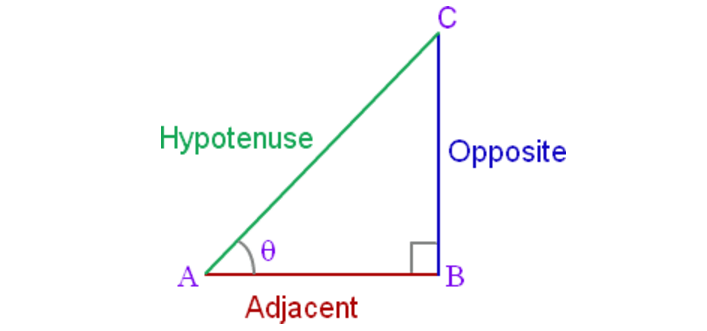
To understand the shortcut, first we have to divide SOHCAHTOA into three parts as given below.

What do SOH, CAH and TOA stand for?
Here is the answer
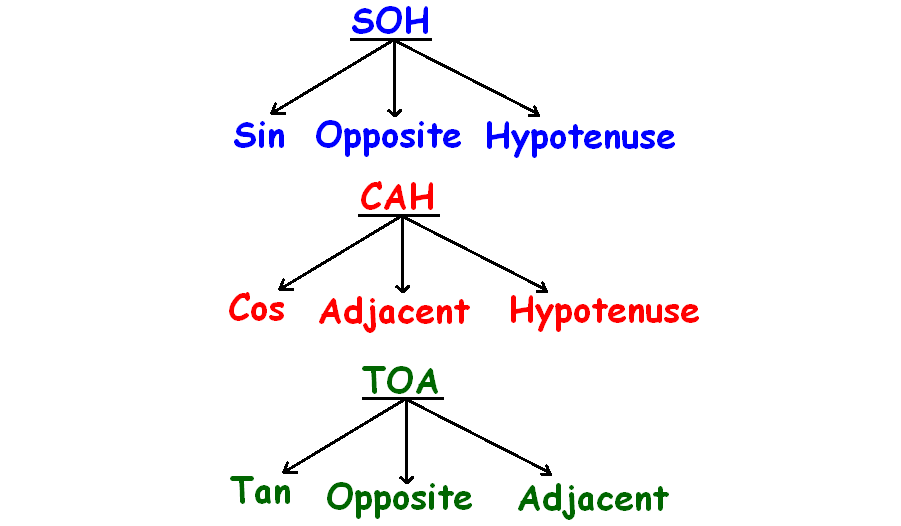
From the above figures, we can derive formulas for the three trigonometric ratios sin, cos and tan as given below.
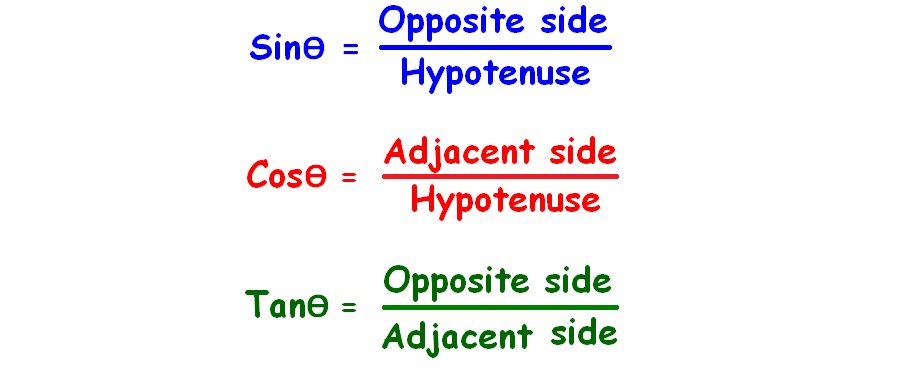
Reciprocal Relations
The trigonometric ratios cscθ, secθ and cotθ are the reciprocals of sinθ, cosθ and tanθ respectively.
|
sinθ = 1/cscθ cosθ = 1/secθ tanθ = 1/cotθ tanθ = sinθ/cosθ |
cscθ = 1/sinθ secθ = 1/cosθ cotθ = 1/tanθ cotθ = cosθ/sinθ |
Solved Problems
Problem 1 :
In the right triangle PQR shown below, find the six trigonometric ratios of the angle θ.

Solution :
In the above right angled triangle, note that for the given angle θ, PQ is the ‘opposite’ side and PR is the ‘adjacent’ side.
Then,
sinθ = opposite side/hypotenuse = PQ/QR = 5/13
cosθ = adjacent side/hypotenuse = PR/QR = 12/13
tanθ = opposite side/adjacent side = PQ/PR = 5/12
cscθ = 1/sinθ = 13/5
secθ = 1/cosθ = 13/12
cotθ = 1/tanθ = 12/5
Problem 2 :
In the figure shown below, find the six trigonometric ratios of the angle θ.
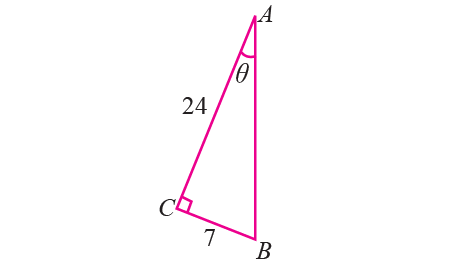
Solution :
In the right angled triangle ABC shown above,
AC = 24
BC = 7
By Pythagorean theorem,
AB2 = BC2 + CA2
AB2 = 72 + 242
AB2 = 49 + 576
AB2 = 625
AB2 = 252
AB = 25
Now, we can use the three sides to find the six trigonometric ratios of angle θ.
sinθ = opposite side/hypotenuse = BC/AB = 7/25
cosθ = adjacent side/hypotenuse = AC/AB = 24/25
tanθ = opposite side/adjacent side = BC/AC = 7/24
cscθ = 1/sinθ = 25/7
secθ = 1/cosθ = 25/24
cotθ = 1/tanθ = 24/7
Problem 3 :
In triangle ABC, right angled at B, 15sin A = 12. Find the other five trigonometric ratios of the angle A.
Solution :
15sinA = 12
sinA = 12/15
sinA = opposite side/hypotenuse
sinA = 12/15
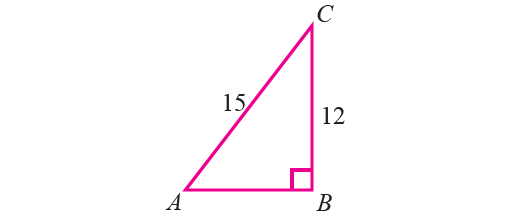
By Pythagorean theorem,
AC2 = AB2 + BC2
152 = AB2 + 122
225 = AB2 + 144
Subtract 144 from each side.
81 = AB2
92 = AB2
9 = AB
Now, we can use the three sides to find the five trigonometric ratios of angle A and six trigonometric ratios of angle C.
cosA = adjacent side/hypotenuse
= AB/AC
= 9/15
= 3/5
tanA = opposite side/adjacent side
= BC/AB
= 12/9
= 4/3
cscA = 1/sinA
= 15/12
= 5/4
secA = 1/cosA
= 5/3
cotA = 1/tanA
= 3/4
Problem 4 :
In the figure shown below, find the values of
sinB, secB, cotB, cosC, tanC and cscC
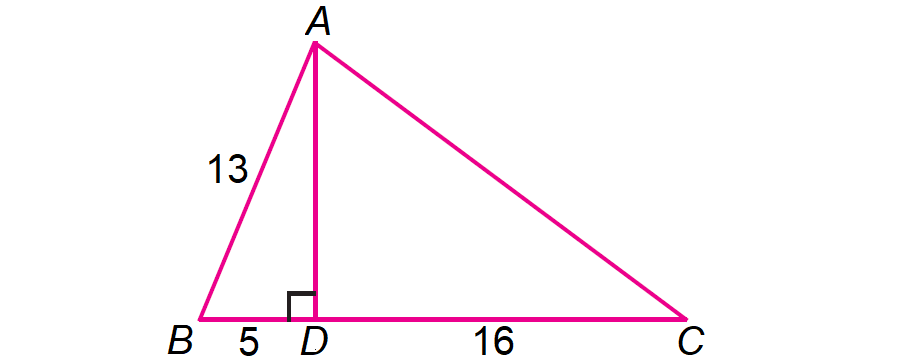
Solution :
In the right ΔABD, by Pythagorean Theorem,
AB2 = AD2 + BD2
132 = AD2 + 52
169 = AD2 + 25
Subtract 25 from each side.
144 = AD2
122 = AD2
12 = AD
In the right ΔACD, by Pythagorean Theorem,
AC2 = AD2 + CD2
AC2 = 122 + 162
AC2 = 144 + 256
AC2 = 400
AC2 = 202
AC = 20
Then,
sinB = opposite side/hypotenuse = AD/AB = 12/13
secB = hypotenuse/adjacent side = AB/BD = 13/5
cotB = adjacent side/opposite side = BD/AD = 5/12
cosC = adjacent side/hypotenuse
= CD/AC
= 16/20
= 4/5
tanC = opposite side/adjacent side
= AD/CD
= 12/16
= 3/4
cscC = hypotenuse/opposite side
= AC/AD
= 20/12
= 5/3
Problem 5 :
A tower stands vertically on the ground. From a point on the ground, which is 48 m away from the foot of the tower, the angle of elevation of the top of the tower is 30°. Find the height of the tower.
Solution :
Let PQ be the height of the tower.
Take PQ = h and QR is the distance between the tower and the point R.
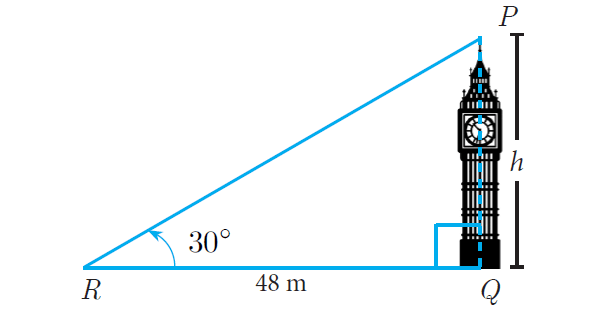
In right triangle PQR above, considering ∠PRQ = 30°, PQ being the opposite side and QR being the adjacent side.
We know the length of the adjacent side (= 48 m) and we have to find the length of the opposite side (height of the tower).
We know that
tanθ = opposite side/adjacent side
In right triangle PQR,
tan∠PRQ = PQ/QR
tan30° = h/48
From trigonometric ratio table, we have tan30° = √3/3.
√3/3 = h/48
Multiply both sides by 48.
48√3/3 = h
16√3 = h
The height of the tower is 16√3 m.
Problem 6 :
A kite is flying at a height of 75 m above the ground. The string attached to the kite is temporarily tied to a point on the ground. The inclination of the string with the ground is 60°. Find the length of the string, assuming that there is no slack in the string.
Solution :
Let AB be the height of the kite above the ground. Then, AB = 75. Let AC be the length of the string.
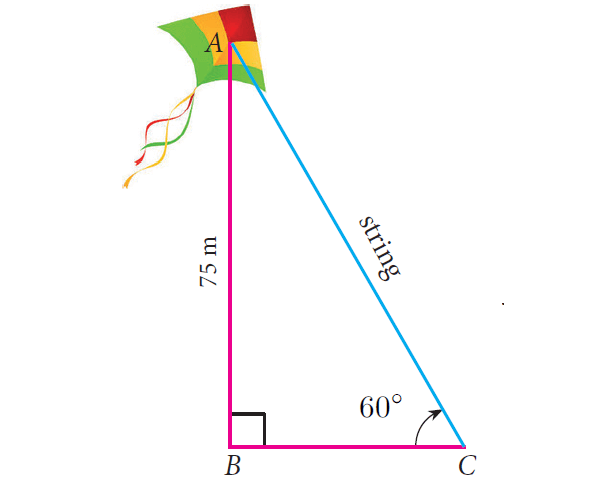
In right triangle ABC above, considering ∠ACB = 60°, AB being the opposite side and AC being the hypotenuse.
We know the length of the opposite side (= 75 m) and we have to find the length of the hypotenuse (length of the string).
We know that
sinθ = opposite side/hypotenuse
In right triangle PQR,
sin∠ACB = AB/AC
sin60° = 75/AC
From trigonometric ratio table, we have sin60° = √3/2.
√3/2 = 75/AC
Take reciprocal on both sides.
2/√3 = AC/75
Multiply both sides by 75.
150/√3 = AC
150√3/3 = AC
50√3 = AC
The length of the string is 50√3.
Subscribe to our ▶️ YouTube channel 🔴 for the latest videos, updates, and tips.
Kindly mail your feedback to v4formath@gmail.com
We always appreciate your feedback.
©All rights reserved. onlinemath4all.com
Recent Articles
-
10 Hard SAT Math Questions (Part - 38)
Dec 08, 25 12:12 AM
10 Hard SAT Math Questions (Part - 38) -
SAT Math Practice
Dec 05, 25 04:04 AM
SAT Math Practice - Different Topics - Concept - Formulas - Example problems with step by step explanation -
10 Hard SAT Math Questions (Part - 37)
Dec 03, 25 07:02 AM
10 Hard SAT Math Questions (Part - 37)


